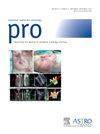On-Table Virtual Reality to Reduce Anxiety/Distress during Radiation Treatments: A Pilot Randomized Trial
IF 3.4
3区 医学
Q2 ONCOLOGY
引用次数: 0
Abstract
We report the first randomized trial of a virtual reality (VR) headset used on-table during external beam radiation therapy (RT) treatments to reduce anxiety/distress during receipt of RT. A small pilot study was conducted among 10 patients, with VR randomized to start in the first week (“immediate VR”) versus the second week (“delayed VR”) of treatment. All patients (100%) in the immediate VR group had declines in measured distress scores after their first radiation treatment, compared to only 1 patient (16.7%) in the delayed VR group (P = .048), yet score declines generally did not meet the minimal clinically important difference threshold in the context of overall low distress scores at baseline. By day 5 of treatment, distress score changes were similar between immediate and delayed VR groups. Overall, 80% of patients in the study, including all patients with moderate or high levels of baseline anxiety/distress, reported that on-table VR improved their RT experience and/or they would recommend VR to others. We propose that on-table VR is a readily available, nonpharmacologic intervention that can be used to help reduce anxiety/distress associated with RT and may be particularly helpful at the start of treatment among those with moderate/high baseline levels of anxiety/distress.
桌上虚拟现实减少放射治疗期间的焦虑/痛苦:一项随机试验。
我们报告了第一项随机试验,在外部放射治疗期间使用虚拟现实(VR)头显来减少接受放射治疗期间的焦虑/痛苦。在10名患者中进行了一项小型试点研究,将VR随机分为治疗的第一周(“立即VR”)和第二周(“延迟VR”)。在第一次放射治疗后,立即VR组的所有患者(100%)测量的窘迫评分下降,而延迟VR组只有1名患者(16.7%)(P = .048),但评分下降通常没有达到最低临床重要差异阈值,在基线时总体窘迫评分较低。治疗第5天,即时和延迟VR组的痛苦评分变化相似。总体而言,研究中80%的患者,包括所有中度或高度基线焦虑/痛苦的患者,报告说桌上VR改善了他们的放疗体验,并且/或者他们会向其他人推荐VR。我们建议,桌上VR是一种容易获得的非药物干预,可用于帮助减少与放疗相关的焦虑/痛苦,并且可能在治疗开始时对那些有中度/高基线焦虑/痛苦水平的患者特别有帮助。
本文章由计算机程序翻译,如有差异,请以英文原文为准。
求助全文
约1分钟内获得全文
求助全文
来源期刊

Practical Radiation Oncology
Medicine-Radiology, Nuclear Medicine and Imaging
CiteScore
5.20
自引率
6.10%
发文量
177
审稿时长
34 days
期刊介绍:
The overarching mission of Practical Radiation Oncology is to improve the quality of radiation oncology practice. PRO''s purpose is to document the state of current practice, providing background for those in training and continuing education for practitioners, through discussion and illustration of new techniques, evaluation of current practices, and publication of case reports. PRO strives to provide its readers content that emphasizes knowledge "with a purpose." The content of PRO includes:
Original articles focusing on patient safety, quality measurement, or quality improvement initiatives
Original articles focusing on imaging, contouring, target delineation, simulation, treatment planning, immobilization, organ motion, and other practical issues
ASTRO guidelines, position papers, and consensus statements
Essays that highlight enriching personal experiences in caring for cancer patients and their families.
 求助内容:
求助内容: 应助结果提醒方式:
应助结果提醒方式:


